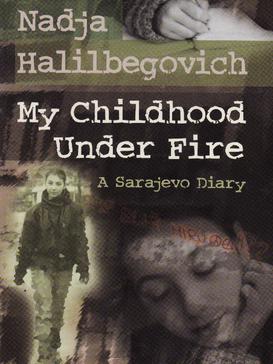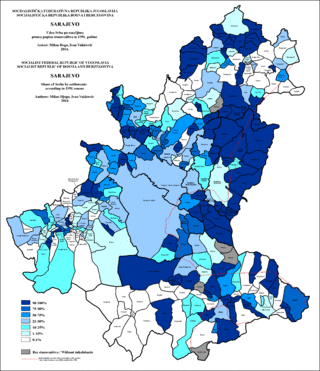
The General Framework Agreement for Peace in Bosnia and Herzegovina, also known as the Dayton Agreement or the Dayton Accords, and colloquially known as the Dayton in ex-Yugoslav parlance, is the peace agreement reached at Wright-Patterson Air Force Base near Dayton, Ohio, United States, finalised on 21 November 1995, and formally signed in Paris, on 14 December 1995. These accords put an end to the three-and-a-half-year-long Bosnian War, which was part of the much larger Yugoslav Wars.

The siege of Sarajevo was a prolonged blockade of Sarajevo, the capital of Bosnia and Herzegovina, during the ethnically charged Bosnian War. After it was initially besieged by Serbian forces of the Yugoslav People's Army, the city was then besieged by the Army of Republika Srpska. Lasting from 5 April 1992 to 29 February 1996, it was three times longer than the Battle of Stalingrad, more than a year longer than the siege of Leningrad, and was the longest siege of a capital city in the history of modern warfare.

The Bosnian War was an international armed conflict that took place in Bosnia and Herzegovina between 1992 and 1995. The war is commonly seen as having started on 6 April 1992, following several earlier violent incidents. It ended on 14 December 1995 when the Dayton Accords were signed. The main belligerents were the forces of the Republic of Bosnia and Herzegovina, the Republic of Herzeg-Bosnia, and the Republika Srpska, the latter two entities being proto-states led and supplied by Croatia and Serbia, respectively.

Geraldine Brooks is an Australian American journalist and novelist whose 2005 novel March won the Pulitzer Prize for Fiction.

Janine di Giovanni is an author, journalist, and war correspondent currently serving as the Executive Director of The Reckoning Project. She is a senior fellow at Yale University's Jackson Institute for Global Affairs, a non-resident Fellow at The New America Foundation and the Geneva Center for Security Policy in International Security and a life member of the Council on Foreign Relations. She was named a 2019 Guggenheim Fellow, and in 2020, the American Academy of Arts and Letters awarded her the Blake-Dodd nonfiction prize for her lifetime body of work. She has contributed to The Times, Vanity Fair, Granta, The New York Times, and The Guardian.

Zlata's Diary: A Child's Life in Sarajevo (ISBN 0-14-024205-8) is a 1992 non-fiction book by Zlata Filipović, who was a young girl living in Sarajevo while it was under siege.

Kemal Kurspahić was a Bosnian journalist. He was managing editor of The Connection Newspapers in Alexandria, Virginia and founder of the media in Democracy Institute, dedicated to promoting higher standards in journalism in post-conflict societies and countries in transition to democracy. He won broad international recognition as the Editor-in-Chief of the Bosnian daily Oslobođenje in Sarajevo, 1989-1994.

Svetlana Broz is a Bosnian author and physician who specializes in cardiology. She is the granddaughter of the Yugoslav leader Josip Broz Tito.
Zlata Filipović is a Bosnian-Irish diarist. She kept a diary from 1991 to 1993 when she was a child living in Sarajevo during the Bosnian War, later published as a book.
Bisera Alikadić is a contemporary Bosnian poet and author, best known best for her work Larva and Krug. She mostly writes romance novels as well as children's books. She was one of the first Bosnian women to publish romance novels. Her books Grad hrabrost and Knjiga vremena express the city of Sarajevo's struggle during the Bosnian War of the 1990s.
Ava Lowery is an American peace activist and documentary filmmaker from Alabama who has created over 100 Flash-based animations denouncing the Iraq War, former United States President George W. Bush, policies of the Republican Party and several individual Republican politicians. She has actively demonstrated against the war, and in support of soldiers.
Operation Irma was the name applied to a series of airlifts of injured civilians from Bosnia and Herzegovina during the siege of Sarajevo. The airlifts were initiated after the wounding of five-year-old Irma Hadžimuratović attracted international media attention. The programme was reported to have evacuated hundreds of Sarajevans during the second half of 1993, but attracted significant controversy concerning its scale, evacuee selection criteria, and the motivations of the western European governments and press that inspired it.

The Perfect Circle is a 1997 Bosnian war drama film by Ademir Kenović set in Sarajevo during the siege of 1992-1996. It was written by Kenović with Pjer Žalica and Abdulah Sidran. The title derives from the ability of "Hamza" to draw perfect circles on paper.

My Childhood Under Fire: A Sarajevo Diary is the Bosnian War diary of the speaker and peace activist Nadja Halilbegovich. The journal was written when Nadja was between ages 12 and 16 and documents the war and Siege of Sarajevo from 1992-1995. The diary was originally published in Bosnia by the humanitarian organization Our Children in two parts: Sarajevsko Djetinjstvo Ratom Ranjeno in 1994 and Sarajevsko Djetinjstvo Ratom Ranjeno: Drugi Dio in 1998. The abridged diary was published in English under the current title by Kids Can Press in the U.S. and Canada in 2006. It has also been published in French in 2007 and Indonesian in 2008. The book chronicles four years of war seen through the eyes of a child and teenager.

Merima Ključo is a Bosnian concert accordionist and composer. In 1993 she moved to the Netherlands as a refugee of the Bosnian War. Currently she is a Bosnian-Dutch citizen. After receiving a Genius visa in 2011 she became an American resident and is based in Los Angeles.

The War Childhood Museum is a historical museum in Sarajevo, Bosnia-Herzegovina that opened in January 2017. The museum presents the experiences of children who lived through the war in Bosnia, told through objects, video testimonies, and excerpts from oral histories. The 2018 Council of Europe Museum Prize, one of the most prestigious awards in the museum industry, was awarded to the War Childhood Museum as part of the 2018 European Museum of the Year Award.

The siege of Goražde refers to engagements during the Bosnian War (1992–95) in and around the town of Goražde in eastern Bosnia.

The Exodus of Sarajevo Serbs was the migration of ethnic Serbs from Sarajevo, the capital of Bosnia and Herzegovina, between January and March 1996 after the Dayton Agreement that concluded the Bosnian War (1992–95).
Tatjana "Tanja" Ljujić-Mijatović is a Bosnian former politician. By vocation, she is a horticulturist and landscape designer. During the Bosnian War, Ljujić-Mijatović served as the Serb member of the Presidency of the Republic of Bosnia and Herzegovina.
Anarchism in Bosnia and Herzegovina first emerged from left-wing currents of the anti-imperialist movement, gaining traction as a tendency in the revolutionary organization Young Bosnia. Following assassination of Archduke Franz Ferdinand and World War I, Bosnia and Herzegovina was brought under a series of authoritarian regimes, before gaining independence in 1992. In the post-independence climate of rising nationalism and income inequality, anarchism re-emerged as part of the nascent anti-nationalist and anti-capitalist movements of the 21st century.















